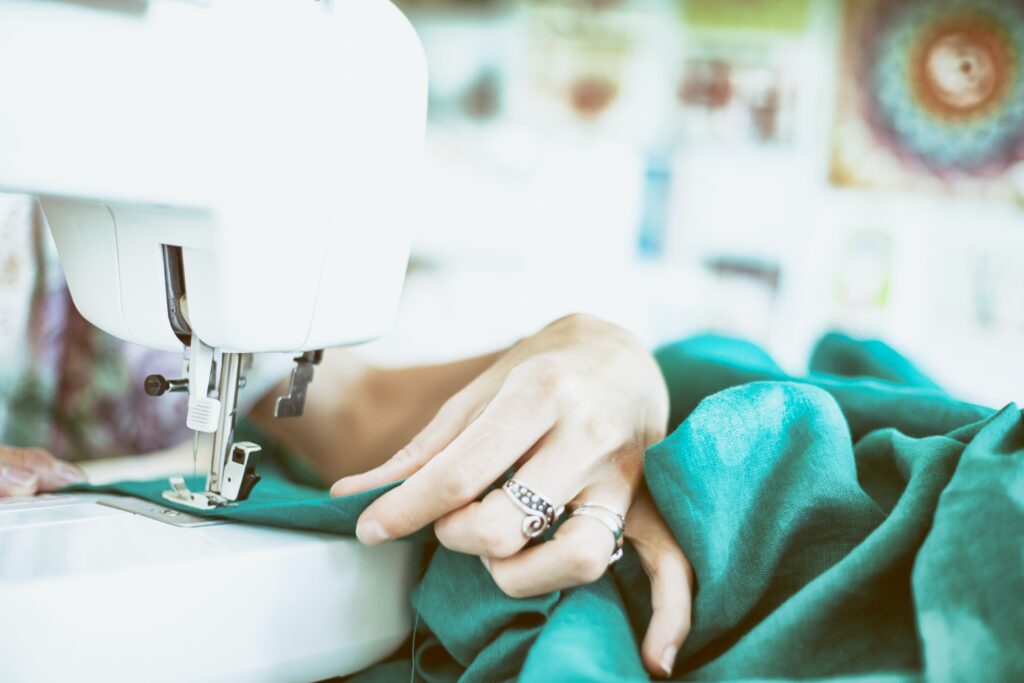Garments that are not quite right often get discarded and replaced. However, with a little know-how and a willingness to try, you can transform these pieces into something you love! Learn three easy ways to mend your clothes, fall back in love with them, and reduce your contribution to landfills.
1. Take Up Hems
Unless you have your clothing made specially to order, it’s likely you have something that doesn’t quite fit — a golden opportunity for learning to take up the hem.
To shorten a garment (usually pants), you’ll need:
- A piece of chalk or soap
- A measuring tape
- Thread the same color as the fabric
- A needle or sewing machine
- Scissors
- Iron and/or sewing pins
Step 1: Put the garment on and mark the desired length with the piece of chalk or soap.
Step 2: Measure the length of the hem to be taken up to ensure an even hem on both sides.
Step 3: Iron the crease to create a sharp line and secure the fold with sewing pins.
Step 4: Hand- or machine-sew a double row of stitches around 1 inch from the bottom to secure the folded length firmly in place.
If the garment is far too long to begin with, you might need to cut it two inches from the desired length before folding the hem twice and sewing the hem by hand or machine.

2. Mend Holes and Gaps in Seams
Another common issue you might find with your clothes is a gap that appears in a seam — either because the thread was accidentally broken (when pulling on tight leggings, for example) or because their was a minor defect at the seam in production. (Even high-quality clothes are sewn by humans operating a sewing a machine, and anyone can have an occasional bad day.) This technique cannot be used for worn seams, such as a crotch, as you’ll need to use a patch instead.
To mend a seam, you will need:
- Thread the same color as the seam
- A needle or sewing machine
- Scissors
Step 1: Turn the garment inside out.
Step 2: Sew over the broken section twice to reinforce the seam.
Step 3: Tie the ends of the new thread to the old thread to stop any further “undoing” and close the hole.
3. Patches: Iron-on and appliqué
Small holes in clothing can rarely be fixed by sewing one side of the hole to the other. The pulling will stretch the garment out of shape and can break the delicate threads around the hole. Instead, you can cover the hole with “visible” mending in the form of an iron-on patch or appliqué.
Iron-On Mending Fabric
Applying iron-on mending fabric is the simplest way to mend a tear or hole because it doesn’t involve any sewing at all. You’ll need:
- Iron-on mending fabric in the same color as the garment – or a funky complementing color or pattern if you want to make it stand-out. This is fun on pants or as patches on sleeves.
- Fabric scissors
- An iron
- Aluminum foil
Step 1: Cut a section of iron-on mending fabric a little larger than the hole or tear. Round the edges for an easier transfer.
Step 2: Put the mending fabric glue side up underneath a tear or over a hole.
Step 3: Preheat the iron on the “cotton” setting for five minutes.
Step 4: Cover the area of fabric with aluminum foil to prevent sticking and press the iron over the patch for 30 seconds or until the section of fabric is firmly attached.
Appliqué
Appliqué is similar to an iron-on patch except that it is attached with thread rather than glue.
For needle turn appliqué, you will need:
- An appliqué patch in the same fabric as the garment
- Appliqué pins
- 100wt thread that matches the garment
- #10 sharps needle
- Chalk or soap for marking
Step 1: Use the chalk or soap to draw a line where the patch will be stitched.
Step 2: Pin the design over the hole.
Step 3: Thread the needle and tie a knot at the end of the thread.
Step 4: Enter from the back of the patch to hide the knot and sew the patch to the garment, tucking the patch under the line and making alternating tiny stitches in the patch and the garment.
Step 5: Once the patch is sewn on, take the thread through to the back and tie it off on the inside of the garment.
The Most Sustainable Wardrobe
It has been said that the most sustainable wardrobe you can get is the one that you already own, and when you add mending to the picture, your current wardrobe can suddenly become much more exciting!
If you’re exploring ways to become more conscious with your clothing and accessories, we invite you to check out the full range of sustainable, ethically-made fashion and jewelry at Faerie’s Dance. Our curated collections of clothing are made with years of wear in mind and many of our necklaces and earrings are recycled!
For more tips on living sustainably in style, read the rest of the posts on our blog.

